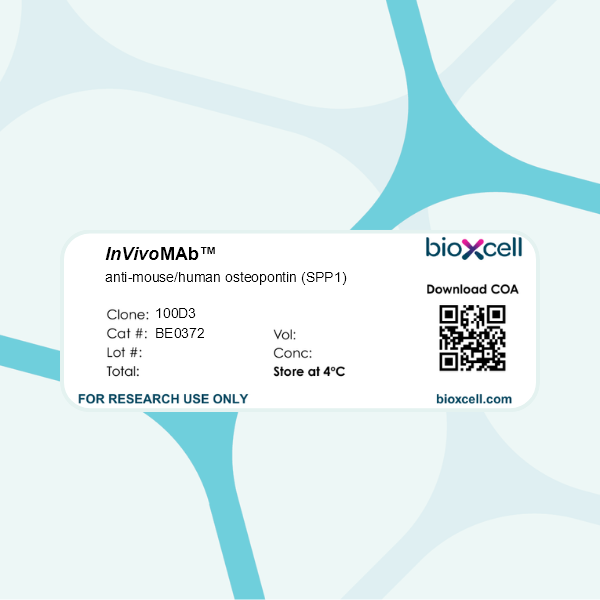InVivoMAb anti-mouse/human osteopontin (SPP1)
Product Description
Specifications
| Isotype | Mouse IgG2c, κ |
|---|---|
| Recommended Isotype Control(s) | InVivoMAb mouse IgG2c isotype control, anti-dengue virus |
| Recommended Dilution Buffer | InVivoPure pH 7.0 Dilution Buffer |
| Conjugation | This product is unconjugated. Conjugation is available via our Antibody Conjugation Services. |
| Immunogen | Recombinant mouse OPN protein |
| Reported Applications |
in vivo OPN neutralization in vitro OPN neutralization ELISA |
| Formulation |
PBS, pH 7.0 Contains no stabilizers or preservatives |
| Endotoxin |
≤1EU/mg (≤0.001EU/μg) Determined by LAL assay |
| Purity |
≥95% Determined by SDS-PAGE |
| Sterility | 0.2 µm filtration |
| Purification | Protein A |
| RRID | AB_2927509 |
| Molecular Weight | 150 kDa |
| Storage | The antibody solution should be stored at the stock concentration at 4°C. Do not freeze. |
| Need a Custom Formulation? | See All Antibody Customization Options |
Application References
in vivo OPN neutralization
in vitro OPN neutralization
ELISA
Klement, J. D., et al. (2021). "Osteopontin Blockade Immunotherapy Increases Cytotoxic T Lymphocyte Lytic Activity and Suppresses Colon Tumor Progression" Cancers (Basel) 13(5).
PubMed
Human colorectal cancers are mostly microsatellite-stable with no response to anti-PD-1 blockade immunotherapy, necessitating the development of a new immunotherapy. Osteopontin (OPN) is elevated in human colorectal cancer and may function as an immune checkpoint. We aimed at elucidating the mechanism of action of OPN and determining the efficacy of OPN blockade immunotherapy in suppression of colon cancer. We report here that OPN is primarily expressed in tumor cells, myeloid cells, and innate lymphoid cells in human colorectal carcinoma. Spp1 knock out mice exhibit a high incidence and fast growth rate of carcinogen-induced tumors. Knocking out Spp1 in colon tumor cells increased tumor-specific CTL cytotoxicity in vitro and resulted in decreased tumor growth in vivo. The OPN protein level is elevated in the peripheral blood of tumor-bearing mice. We developed four OPN neutralization monoclonal antibodies based on their efficacy in blocking OPN inhibition of T cell activation. OPN clones 100D3 and 103D6 increased the efficacy of tumor-specific CTLs in killing colon tumor cells in vitro and suppressed colon tumor growth in tumor-bearing mice in vivo. Our data indicate that OPN blockade immunotherapy with 100D3 and 103D6 has great potential to be further developed for colorectal cancer immunotherapy and for rendering a colorectal cancer response to anti-PD-1 immunotherapy.
in vivo OPN neutralization
in vitro OPN neutralization
ELISA
Klement, J. D., et al. (2021). "Osteopontin Blockade Immunotherapy Increases Cytotoxic T Lymphocyte Lytic Activity and Suppresses Colon Tumor Progression" Cancers (Basel) 13(5).
PubMed
Human colorectal cancers are mostly microsatellite-stable with no response to anti-PD-1 blockade immunotherapy, necessitating the development of a new immunotherapy. Osteopontin (OPN) is elevated in human colorectal cancer and may function as an immune checkpoint. We aimed at elucidating the mechanism of action of OPN and determining the efficacy of OPN blockade immunotherapy in suppression of colon cancer. We report here that OPN is primarily expressed in tumor cells, myeloid cells, and innate lymphoid cells in human colorectal carcinoma. Spp1 knock out mice exhibit a high incidence and fast growth rate of carcinogen-induced tumors. Knocking out Spp1 in colon tumor cells increased tumor-specific CTL cytotoxicity in vitro and resulted in decreased tumor growth in vivo. The OPN protein level is elevated in the peripheral blood of tumor-bearing mice. We developed four OPN neutralization monoclonal antibodies based on their efficacy in blocking OPN inhibition of T cell activation. OPN clones 100D3 and 103D6 increased the efficacy of tumor-specific CTLs in killing colon tumor cells in vitro and suppressed colon tumor growth in tumor-bearing mice in vivo. Our data indicate that OPN blockade immunotherapy with 100D3 and 103D6 has great potential to be further developed for colorectal cancer immunotherapy and for rendering a colorectal cancer response to anti-PD-1 immunotherapy.
Product Citations
-
-
Immunology and Microbiology
-
Stem Cells and Developmental Biology
Dermal TRPV1 innervations engage a macrophage- and fibroblast-containing pathway to activate hair growth in mice.
In Dev Cell on 4 November 2024 by Ben-Shaanan, T. L., Knöpper, K., et al.
PubMed
Pain, detected by nociceptors, is an integral part of injury, yet whether and how it can impact tissue physiology and recovery remain understudied. Here, we applied chemogenetics in mice to locally activate dermal TRPV1 innervations in naive skin and found that it triggered new regenerative cycling by dormant hair follicles (HFs). This was preceded by rapid apoptosis of dermal macrophages, mediated by the neuropeptide calcitonin gene-related peptide (CGRP). TRPV1 activation also triggered a macrophage-dependent induction of osteopontin (Spp1)-expressing dermal fibroblasts. The neuropeptide CGRP and the extracellular matrix protein Spp1 were required for the nociceptor-triggered hair growth. Finally, we showed that epidermal abrasion injury induced Spp1-expressing dermal fibroblasts and hair growth via a TRPV1 neuron and CGRP-dependent mechanism. Collectively, these data demonstrated a role for TRPV1 nociceptors in orchestrating a macrophage and fibroblast-supported mechanism to promote hair growth and enabling the efficient restoration of this mechano- and thermo-protective barrier after wounding.
-

